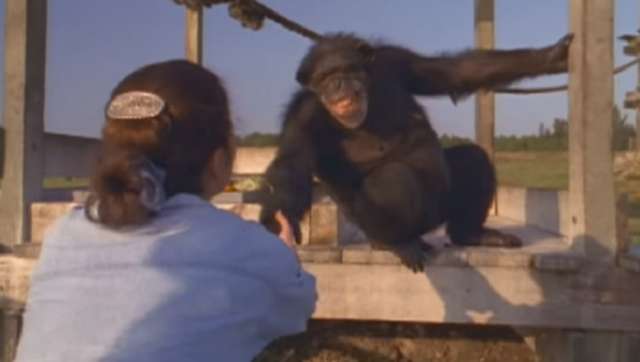Since the 1920s, the notion of chimpanzees possessing phenomenal strength has been a feature of pop-culture and a common subject for study in biology.
A number of studies across the decades have suggested that pound-for-pound, chimpanzees could be as much as 3 to nearly 5 times stronger than a strapping human, or as little as 2.5 times.
Even recent conservative calculations place their relative strength at around double our own, but most of the studies have been based on a chimp trying to move a heavy mass, and then having a human do the same thing.
This makes it hard to separate the effects of muscle arrangement, the contributions of tendons, or the effect of overall body shape from the actual strength of the muscles.
"There are nearly 100 years of accounts suggesting that chimpanzees must have intrinsically superior muscle fibre properties compared with humans, yet there had been no direct tests of that idea," says Brian Umberger from the University of Massachusetts Amherst.
So keeping this in mind, a team of US researchers dug deeper into the wealth of research conducted between 1923 and 2014 and came to the conclusion that a more accurate interpretation of the data is that while chimpanzees are consistently stronger, they are on average only about 1.5 times stronger than us.
That still doesn't make it a good idea to get into a wrestling match with one.
To put this number to the test and discover why chimp muscles were stronger than ours, the team isolated muscle fibres and tested their overall force and velocity as they contracted. They also examined the tissue's distribution of 'motor proteins' called myosin.
Muscle fibres tend to come in two varieties – slow-twitch and fast-twitch, each of which with its own characteristic pattern of myosin chains.
Slow-twitch can work for longer periods without tiring, and are the endurance champions of your muscle fibres. Fast-twitch, on the other hand, are the sprinters, tiring fast but putting in a strong effort quickly.
The researchers found chimpanzee muscle fibres were longer than those of humans and were present in different ratios.
"We found that within fibre types, chimp and human muscle fibres were actually very similar. However, we also found that chimps have about twice as many fast-twitch fibres as humans," says Umberger.
Plugging the data into a computer simulation suggested such differences could result in muscles that were 1.35 times stronger than ours, coming pretty close to the team's estimate based on the literature.
Putting this into an evolutionary context, it would make sense that human muscles sacrificed a small amount of brute strength for more slow-twitch fibres.
"When we compared chimps and humans to muscle fibre type data for other species we found that humans are the outlier, suggesting that selection for long distance, over-ground travel may have been important early in the evolution of our musculoskeletal system," says Umberger.
The chimpanzee's more arboreal lifestyle would make more fast-twitch fibres an advantage to give them a boost climbing and swinging through branches.
As the hominid family line branched off, humans took advantage in moving over long distances for extended periods.
In terms of natural selection, it doesn't seem as if the properties of human and chimpanzee muscle cells have changed a great deal, even while their distribution and size have adapted to different needs.
More about: #Chimpanzee















































